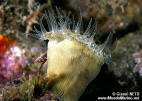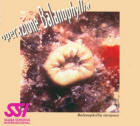CORAL STUDIES
“Alma Idea” project funded by the University of Bologna, aims at studying the effects of ocean acidification on growth, skeletal characteristics and microbial communinties in populations of Mediterranean corals that naturally colonize reefs close to volcanic carbon dioxyde emissions. This multidisciplinary project uses natural laboratories near the islands of Ischia and Panarea, integrating ecological, physical, and microbiological approaches, thanks to the collaboration with the Department of Physics and Astronomy and with the Department of Pharmacy and Biotechnology of the University of Bologna.

Assessment of the health status of the colonial coral Astroides calycularis along Italian coasts
The project is being carried out in collaboration with the Marine Ecology Laboratory of the Institute for Coastal Marine Environment – National Research Council – of Castellammare del Golfo, Trapani (Dr Fabio Badalamenti). This study aims at defining the spatial distribution and the health status of A. calycularis along the Italian coasts with an emphasis on the identification of those aspects that are most relevant to its conservation. SCIs (Sites of Community Importance) will be proposed based on the distribution, characteristics, health and habitat of the A. calycularis facies, in order to provide guidelines for the management and conservation of the habitat of this species. Collaborations with the Department of Physics and Astronomy (UniBo) are foreseen for computed tomography and nuclear magnetic resonance analysis.

Ocean acidification effects on tropical coral species at Papua New Guinea
The project is being performed in collaboration with the Australian Institute of Marine Science (Dr Katharina Fabricius), to investigate the effect of long-term exposure to acidified conditions on he skeletal characteristics of six tropical coral specie naturally occurring at the volcanic CO2 vents in Papua New Guinea. Collaborations with the Department of Physics and Astronomy (UniBo) will allow us to apply nuclear magnetic resonance to investigate the pore size distribution of the skeletons of the investigated species.
Mediterranean corals research themes

The reproductive cycles of Mediterranean scleractinians are defined by using hystological tchniques. The definition of sexuality and reproductive mode is perfomed through observation of hystological samples by optical microscopy. Cytometric measurements are performed by using image analysis software. The observations allow to identify and quantify the germ cells in each polyp, thus delineating the gonadal maturation stages, the fertilization time, and the embryogenesis, which will culminate in the planulation of new individuals. The sexual reproduction cycle is influenced by the seasonal variations of seawater temperature and photoperiod. The analyses are performed on populations characterized by different environmental parameters, to verify their influence on reproductive traits of the studied species.

The relationships between morphological features of skeletons along the lifespan of the animal are analyzed. Skeleton age can be determined through sclerochronology, that is the observation of the typical yearly growth bands of the skeleton. By applying mathematical models, it is possible to determine polyp growth rates along their lifespan, based both on sclerochronological data and on field measurements. From these data, the main growth characteristics are determined: linear extension, skeletal density, and calcification. By analyzing population age structures and applying proper models, important demographic parameters of the populations are derived, such as mortality rate, average lifespan, and yield. All these characteristics are compared among populations subjected to different environemntal parameters, and among different scleractinian species.

The process responsible for the formation of scleractinian skeletons, which are composed by calcium carbonate and by an intraskeletal organic matrix, is analyzed. Both skeletal analyses and in vitro crystallization experiments are performed, to understand the skeletal precipitation process and the level of control by the organism. The skeleton is analyzed by infrared spectroscopy (FTIR), X ray diffractometry (XRD), and thermogravitometry (TGA). These analyses are used to determine the composition of the skeletons and to quantify the percentage of organic matrix inside them. Then, in vitro crystallization experiments are performed with the presence of different concentrations of magnesium (environmental control) and organic matrix (biologic control) extracted by the skeleton. Experimental products are analyzed through microscopic techniques, to assess possible morphological variations, and spectroscopic techniques, to verify the precipitated calcium carbonate polymorph. Different species and populations at different environmental parameters are compared.

Self-fertilization rates are studied by using molecular biology techniques aimed at particular DNA sequences, called microsatellite sequences. These sequences allow to assess the genetic differences between adult individuals and their progeny. It is also possible to assess the genetic variability and connectivity among different populations.

Investigation of mechanical properties benefits of recent techiniques of instrumented nanoindentation. Indenting means: to bring to contact the indentator-probe, which is highly rigid and unaltered by the interaction, and the sample. During this procedure, the instrument measures the applied force and the depth of penetration in time. The software can assess the hardness (resistance of the materiaal to plastic deformation) and the Young’s elastic modulus (response in a ragime of reversible deformation), which are the two quantities who better define the mechanical features of an object. Before the indentation, a study of porosity is perfomed through nuclear magnetic resonance (NMR) in the time domains, to obtain information on the quantity and size of skeletal pores.
Closed projects

Effect of ocean acidifcation on the coral Astroides calycularis
A project in collaboration with the Laboratory of Functional and Evolutionary Ecology of the Zoological Station Anton Dohrn in Napoli (Dott. Maria Cristina Gambi), studing the skeletal and growth characteristics of Astroides calycularis at the volcanic CO2 vents in Ischia. Collaborations with the Department of Physics and Astronomy are forseen for sclerochronological analyses. This activity is part of the High-CO2 Seas project, funded by Total Foundation, which involves also the University of Perpignan, the University Pierre and Marie Curie, the National Institute of Oceanography and Experimental Geophysics, the Stanford University, the University of California, and the Spanish National Research Council.
Vai al sito del progetto

SpaceBioMat is a project that was financed by the European Space Agency (ESA) in 2014 under the scheme Topical Team (TT). TTs are research networks selected by ESA with the purpose of organizing forums for the incubation of ideas for future spaceflight mission projects. ESA provides coaching and supervision for TT members by organizing ad-hoc meetings where ESA staff and researchers discuss details on experiments that will be conducted under different gravity conditions. The experiments, initially performed using Ground Based Facilities (GBF) at ESTEC (European Space Research and Technology Centre, Noordwijk, Netherlands) could potentially be repeated on the International Space Station (ISS) in the future. SpaceBioMat main proponents are Giuseppe Falini from the University of Bologna, Zvy Dubinsky from Bar-Ilan University, Jaap Kaandorp from the University of Amsterdam, and Stefano Goffredo, with the involvement of MSG researchers as team members. Through ESA supervision, SpaceBioMat aims to create an orbiting aquatic biomineralization research bioreactor, which allows to perform experiments under hyper or hypo gravity conditions, to understand how altered gravity can influence biomineralization processes in marine organisms.

Project financed by the European Research Council under the IDEAS scheme of the VII Framework Program. Conceived by MSG, it has the aim of studying the potential effects of global warming and acidification on biology and ecology of Mediterranean and Red Sea corals. The project is multidisciplinary, in that it uses biological, chemical and physical techniques, and it benefits from the collaboration between the labs of the University of Bologna and the Bar-Ilan University of Tel Aviv.
Go to project website

This project, funded by the European Institutes of Advanced Studies (EURIAS), aims to determine the extent of self-fertilization for population maintenance as well as the effects of population demography on rates of self-fertilization in the Mediterranean coral Balanophyllia europaea. Using microsatellites, baseline genotypic diversity will be determined and rates of self-fertilization compared among sites of varying density to test for associations with population demography. It is hypothesized that as habitat destruction and deterioration increases and population density declines, rates of self-fertilization will increase as distances between individuals increases. Understanding how rates of self-fertilization vary with environmental parameters will assist in efforts to predict future changes to coral populations associated with global climate change.
Thanks to the project “Protecting the Gulf of Aqaba from Anthropogenic and Natural Stress” which is supported by the program “The NATO Science for Peace and Security Programme (SPS)”, a model will be developed to verify the current situation and the future modifications of water quality in the Aqaba Gulf (Red Sea). The model will be useful to assess the degeneration of water conditions near the cities of Aqaba (Jordan) and Eilat (Israel), to project the environmental conditions of the gulf and the consequent restoration actions that may be adopted to protect it.
READ THE PRESENTATION

Fungidae – Study of ecological distribution, abundance and population dynamics of tropical mushroom corals from the Red Sea. An international Italian-Israeli collaboration with the Interuniversity Institute for Marine Science of Eilat.

started on 1997, was the first research on reproductive mode and demographic characteristics of Mediterranean hard corals.
Read the project report


